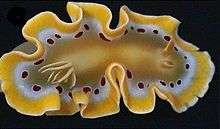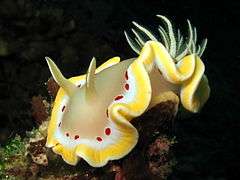Ardeadoris cruenta
Ardeadoris cruenta is a species of very colourful sea slug, a dorid nudibranch, a marine gastropod mollusc in the family Chromodorididae.[2] Its name is derived from the feminine form of the Latin word cruentus, which means "stained with blood" and is a reference to the red spots on its upper dorsum.[3] It was transferred to the genus Ardeadoris on the basis of DNA evidence.[4]
| Ardeadoris cruenta | |
|---|---|
 | |
| Ardeadoris cruenta | |
| Scientific classification | |
| Kingdom: | Animalia |
| Phylum: | Mollusca |
| Class: | Gastropoda |
| Subclass: | Heterobranchia |
| Order: | Nudibranchia |
| Suborder: | Doridina |
| Superfamily: | Doridoidea |
| Family: | Chromodorididae |
| Genus: | Ardeadoris |
| Species: | A. cruenta |
| Binomial name | |
| Ardeadoris cruenta | |
| Synonyms[2] | |
| |
Distribution
This species was described from Osprey Island, Great Barrier Reef, Australia, in the tropical Western Pacific Ocean. It has also been recorded from the Philippines, the Lembeh Strait in northern Sulawesi, East Timor and the Solomon Islands. This species of nudibranch is not common.[5]
Description

Ardeadoris cruenta has a pale-lemon colored body with a bright yellow and white lined frilly mantle and foot. There are red dots in a circular pattern on its dorsum next to the mantle edge. Both its rhinophores and gills have the same pale-lemon color as its body, although there is some color variation among individuals. It reaches a length of at least 50 mm.[6][7] This species has similar coloring to the seaslug Ardeadoris rubroannulata, although that species lacks the red dots present in Ardeadoris cruenta.[8]
Ecology
Like other Chromodorids, this species feeds on sponges.[9]
References
- Rudman W.B. (1986) The Chromodorididae (Ophistobranchia: Mollusca) of the Indo-West Pacific: the genus Glossodoris Ehrenbergh (= Casella, H. & A; Adams). Zoological Journal of the Linnean Society 86: 101-184. page(s): 167
- Bouchet, P. (2012). Ardeadoris cruenta. Accessed through: World Register of Marine Species on 2012-06-18
- Definition of cruentus from Wiktionary
- Johnson R.F. & Gosliner T.M. (2012) Traditional taxonomic groupings mask evolutionary history: A molecular phylogeny and new classification of the chromodorid nudibranchs. PLoS ONE 7(4): e33479
- Rudman, W.B., 2000 (October 25) Glossodoris cruenta Rudman, 1986. [In] Sea Slug Forum. Australian Museum, Sydney.
- Rudman W.B. (1990) The Chromodorididae (Opisthobranchia: Mollusca) of the Indo-West Pacific: further species of Glossodoris, Thorunna and the Chromodoris aureomarginata colour group. Zoological Journal of the Linnean Society 100: 263-326 page(s): 279, 324
- Debelius, H. & Kuiter, R.H. (2007) Nudibranchs of the world. ConchBooks, Frankfurt, 360 pp. ISBN 978-3-939767-06-0 page(s): 191
- Gosliner, T.M., Behrens, D.W. & Valdés, Á. (2008) Indo-Pacific Nudibranchs and seaslugs. A field guide to the world's most diverse fauna. Sea Challengers Natural History Books, Washington, 426 pp. page(s): 238
- Rudman, W.B., 2006 (Jul 28) Comment on Beautiful chromodorid from East Timor by Brian Francisco. [Message in] Sea Slug Forum. Australian Museum, Sydney.